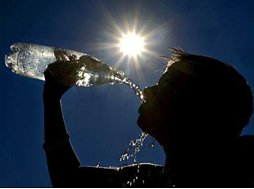Baby sunscreen
Although there is a large variety of baby sunscreen being offered today, there is a certain amount of controversy to be aware of.

2 very important facts about baby sunscreen:
Baby skin coping with toxic sunscreen ingredients.
Babies, infants and children have what is called a high body surface to volume ratio.
What this means is that proportionately babies have more skin for their size of body when compared to adults.
Sunscreens, including any specifically labelled 'baby sunscreen', are made of either chemicals or minerals. If you use a chemical based sunscreen on an older child and adult, the chemical exposure is relatively minimal because the body surface ratio is smaller than a baby or child's.
So, if you choose to use a chemical based sunscreen, your baby or child will absorb a far higher amount than an adult, based on their higher body surface to volume ratio. Some of these chemical sunscreen ingredients are extraordinarily toxic, making the chance for an adverse reaction more than reasonably high.
A mineral sunscreen such as Zinc Oxide however, will stay on the surface of the skin and is considered extremely benign.
 Keep hydrated
Keep hydratedHydration for babies in the sun.
Babies have a mildly impaired mechanism to keep cool by sweating.
They also have a greater risk of becoming dehydrated due to heat.
Sunscreen can actually impair their effective cooling system by perspiration, so placing too much of it on your baby could create a negative rather than a positive reaction.
Baby sunscreen and dehydration tips
- Under 6 months:
Babies skin up to the age of 6 months is really delicate and not yet accustomed to either the sun's UV rays or the atmospheric toxins present everywhere today.
The general rule is to keep your baby out of the direct sun until older than 6 months. - Hydrate!
Feed your baby frequently, either with breast milk or formula. There is plenty water content in either of these to maintain a well hydrated baby.
Contrary to many people's thinking, a little extra water is fine for your baby, but you need to be careful not to have them drink too much, which can actually cause a water intoxication which has even been known to cause a seizure.
 Sun clothing protection for babies
Sun clothing protection for babies- Use non-toxic baby sunscreen.
Protect exposed areas such as the face, feet and hands with a non-toxic sunscreen.
Use a physical or mineral based sunscreen without any chemical sunscreens or any other toxic cosmetic ingredients. Preferably a zinc oxide only sunscreen with added antioxidants. - Shade.
If you can get your baby to wear a hat, you'll find this will become acceptable through the years but it may require huge powers of persuasion to find one they are comfortable with.
Also, use an umbrella or a canopy wherever possible.
If out walking, try to make sure you have a canopy for either your stroller or your backpack.
If at the beach, there are many shade options available these days. - Protective clothing.
Try to obtain specific UPF clothing that uses material with certified sun protection for the skin from both UVA and UVB rays.
This clothing is light and enables the skin to breathe.
There are also UPF options available in blankets.
All of these help to supplement the use of a sunscreen.





New! Comments
Have your say... please leave me a comment in the box below.